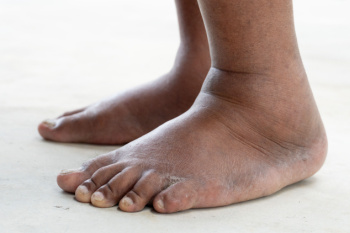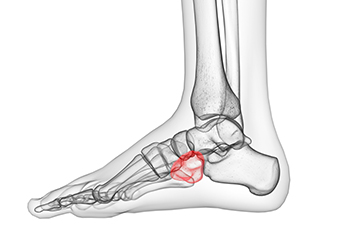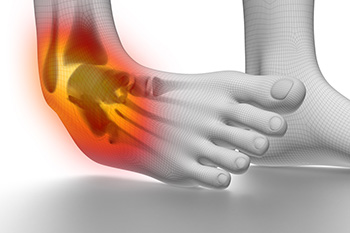Merrillville, IN
Munster, IN
October 2024
Risk Factors and Diagnosis of Gout

Gout is a form of inflammatory arthritis that causes sudden and severe pain, swelling, and redness in the joints, often affecting the big toe. This condition arises from the accumulation of uric acid crystals in the joints, leading to intense inflammation. Various risk factors contribute to the development of gout, including a diet high in purines, obesity, excessive alcohol consumption, and certain medical conditions such as hypertension and diabetes. Diagnosis of gout typically involves a thorough medical history, a physical examination, and tests to measure uric acid levels in the blood. In some cases, a joint fluid analysis may be performed to confirm the presence of uric acid crystals. Early diagnosis and management are vital to prevent recurrent attacks and joint damage. Gout can be painful, hindering daily activities. If you have had one or more gout attacks, it is suggested that you are under the care of a podiatrist who can help you to manage this condition.
Gout is a foot condition that requires certain treatment and care. If you are seeking treatment, contact Ahmad Elsamad, DPM from The Institute of Foot & Ankle Reconstructive Surgery . Our doctor will treat your foot and ankle needs.
What Is Gout?
Gout is a type of arthritis caused by a buildup of uric acid in the bloodstream. It often develops in the foot, especially the big toe area, although it can manifest in other parts of the body as well. Gout can make walking and standing very painful and is especially common in diabetics and the obese.
People typically get gout because of a poor diet. Genetic predisposition is also a factor. The children of parents who have had gout frequently have a chance of developing it themselves.
Gout can easily be identified by redness and inflammation of the big toe and the surrounding areas of the foot. Other symptoms include extreme fatigue, joint pain, and running high fevers. Sometimes corticosteroid drugs can be prescribed to treat gout, but the best way to combat this disease is to get more exercise and eat a better diet.
If you have any questions please feel free to contact our offices located in Merrillville, and Munster, IN . We offer the newest diagnostic and treatment technologies for all your foot and ankle needs.
Understanding Foot Stress Fractures

A foot stress fracture is a small crack in a bone caused by repetitive force or overuse, often seen in athletes or individuals engaging in high-impact activities. Common symptoms include localized pain that worsens with activity, tenderness, swelling, and bruising surrounding the affected area. Individuals may also experience discomfort while walking or standing for extended periods. To relieve the pain and promote healing, rest is vital, allowing the body to recover without further stress on the injured foot. Elevating the foot helps minimize discomfort, and in some cases, wearing a supportive brace or orthotics can provide additional stability. Gradually returning to activity, along with strengthening and stretching exercises, can help prevent future injuries. If you have suffered a foot stress fracture, it is suggested that you contact a podiatrist who can effectively diagnose and treat this condition.
Activities where too much pressure is put on the feet can cause stress fractures. To learn more, contact Ahmad Elsamad, DPM from The Institute of Foot & Ankle Reconstructive Surgery . Our doctor can provide the care you need to keep your pain free and on your feet.
Dealing with Stress Fractures of the Foot and Ankle
Stress fractures occur in the foot and ankle when muscles in these areas weaken from too much or too little use. The feet and ankles then lose support when walking or running from the impact of the ground. Since there is no protection, the bones receive the full impact of each step. Stress on the feet can cause cracks to form in the bones, thus creating stress fractures.
What Are Stress Fractures?
Stress fractures occur frequently in individuals whose daily activities cause great impact on the feet and ankles. Stress factors are most common among:
- Runners
- People affected with Osteoporosis
- Tennis or basketball players
- Gymnasts
- High impact workouts
Symptoms
Pain from the fractures occur in the area of the fractures and can be constant or intermittent. It will often cause sharp or dull pain with swelling and tenderness. Engaging in any kind of activity which involves high impact will aggravate pain.
If you have any questions please feel free to contact our offices located in Merrillville, and Munster, IN . We offer the newest diagnostic and treatment technologies for all your foot and ankle needs.
Swollen Feet in the Elderly

Swollen feet are a common issue among the elderly and can arise from various underlying causes. One significant factor is congestive heart failure, which occurs when the heart struggles to pump blood effectively, leading to fluid accumulation in the extremities. Additionally, certain medications, such as those for high blood pressure or diabetes, can contribute to swelling as a side effect. Edema, a condition noted for fluid retention in the tissues, is also prevalent among older adults and can result from kidney problems or prolonged immobility. Early identification can lead to effective management strategies, improving comfort and overall health for elderly patients. If you are elderly or you are taking care of an elderly person who has swollen feet, it is suggested that you contact a podiatrist who can diagnose the cause and provide treatment.
Proper foot care is something many older adults forget to consider. If you have any concerns about your feet and ankles, contact Ahmad Elsamad, DPM from The Institute of Foot & Ankle Reconstructive Surgery . Our doctor can provide the care you need to keep you pain-free and on your feet.
The Elderly and Their Feet
As we age we start to notice many changes in our body, but the elder population may not notice them right away. Medical conditions may prevent the elderly to take notice of their foot health right away. Poor vision is a lead contributor to not taking action for the elderly.
Common Conditions
- Neuropathy – can reduce feeling in the feet and can hide many life-threatening medical conditions.
- Reduced flexibility – prevents the ability of proper toenail trimming, and foot cleaning. If left untreated, it may lead to further medical issues.
- Foot sores – amongst the older population can be serious before they are discovered. Some of the problematic conditions they may face are:
- Gouging toenails affecting nearby toe
- Shoes that don’t fit properly
- Pressure sores
- Loss of circulation in legs & feet
- Edema & swelling of feet and ankles
Susceptible Infections
Diabetes and poor circulation can cause general loss of sensitivity over the years, turning a simple cut into a serious issue.
If you have any questions please feel free to contact our offices located in Merrillville, and Munster, IN . We offer the newest diagnostic and treatment technologies for all your foot and ankle needs.
Causes and Prevalence of Cuboid Syndrome

Cuboid syndrome is a foot condition that affects the cuboid bone, often resulting in pain and discomfort on the outer side of the foot. This syndrome typically arises from ankle injuries, overuse, or repetitive stress, particularly in athletes engaged in high-impact sports. Symptoms include localized pain, swelling, and difficulty walking or bearing weight on the affected foot. Although cuboid syndrome is not as widely recognized as other foot injuries, it is relatively common among active individuals. Those who participate in sports such as running, soccer, or basketball are at greater risk due to the demands placed on their feet. Understanding cuboid syndrome is vital for prompt diagnosis and treatment. This allows patients to manage their symptoms effectively and return to their activities without prolonged discomfort. If you have pain in this area of your foot, it is suggested that you consult a podiatrist who can accurately diagnose and treat what cuboid syndrome.
Cuboid syndrome, also known as cuboid subluxation, occurs when the joints and ligaments near the cuboid bone in the foot become torn. If you have cuboid syndrome, consult with Ahmad Elsamad, DPM from The Institute of Foot & Ankle Reconstructive Surgery . Our doctor will assess your condition and provide you with quality foot and ankle treatment.
Cuboid syndrome is a common cause of lateral foot pain, which is pain on the outside of the foot. The condition may happen suddenly due to an ankle sprain, or it may develop slowly overtime from repetitive tension through the bone and surrounding structures.
Causes
The most common causes of cuboid syndrome include:
- Injury – The most common cause of this ailment is an ankle sprain.
- Repetitive Strain – Tension placed through the peroneus longus muscle from repetitive activities such as jumping and running may cause excessive traction on the bone causing it to sublux.
- Altered Foot Biomechanics – Most people suffering from cuboid subluxation have flat feet.
Symptoms
A common symptom of cuboid syndrome is pain along the outside of the foot which can be felt in the ankle and toes. This pain may create walking difficulties and may cause those with the condition to walk with a limp.
Diagnosis
Diagnosis of cuboid syndrome is often difficult, and it is often misdiagnosed. X-rays, MRIs and CT scans often fail to properly show the cuboid subluxation. Although there isn’t a specific test used to diagnose cuboid syndrome, your podiatrist will usually check if pain is felt while pressing firmly on the cuboid bone of your foot.
Treatment
Just as the range of causes varies widely, so do treatments. Some more common treatments are ice therapy, rest, exercise, taping, and orthotics.
If you have any questions, please feel free to contact our offices located in Merrillville, and Munster, IN . We offer the newest diagnostic and treatment technologies for all your foot care needs.
Gout Pain Can Be Managed
Risk Factors for Ankle Sprains and Strains

The ankles are remarkable joints that enable a wide range of movement, but they are also vulnerable to injuries such as sprains and strains. An ankle sprain, which is quite common, occurs when a ligament is overstretched or torn, while a strain involves overstretching or tearing of a muscle or tendon. Factors that can heighten the risk of these injuries include inadequate athletic conditioning, skipping warm-ups before exercise, pushing through muscle fatigue, carrying excess weight, and wearing unsupportive or poorly fitting shoes. These conditions can lead to significant pain and impact your mobility. To properly diagnose and treat ankle injuries, it is important to consult a professional. A podiatrist can provide expert evaluation, treatment options, and preventive advice to help you recover and reduce the risk of future injuries. If you are experiencing ankle pain, it is suggested you schedule an appointment with a podiatrist for personalized care and effective treatment.
Ankle sprains are common but need immediate attention. If you need your feet checked, contact Ahmad Elsamad, DPM from The Institute of Foot & Ankle Reconstructive Surgery . Our doctor can provide the care you need to keep you pain-free and on your feet.
How Does an Ankle Sprain Occur?
Ankle sprains take place when the ligaments in your ankle are torn or stretched beyond their limits. There are multiple ways that the ankle can become injured, including twisting or rolling over onto your ankle, putting undue stress on it, or causing trauma to the ankle itself.
What Are the Symptoms?
- Mild to moderate bruising
- Limited mobility
- Swelling
- Discoloration of the skin (depending on severity)
Preventing a Sprain
- Wearing appropriate shoes for the occasion
- Stretching before exercises and sports
- Knowing your limits
Treatment of a Sprain
Treatment of a sprain depends on the severity. Many times, people are told to rest and remain off their feet completely, while others are given an air cast. If the sprain is very severe, surgery may be required.
If you have suffered an ankle sprain previously, you may want to consider additional support such as a brace and regular exercises to strengthen the ankle.
If you have any questions please feel free to contact our offices located in Merrillville, and Munster, IN . We offer the newest diagnostic and treatment technologies for all your foot and ankle needs.








